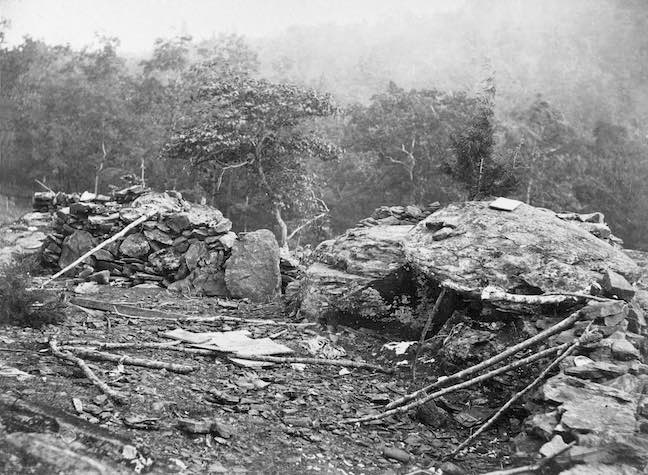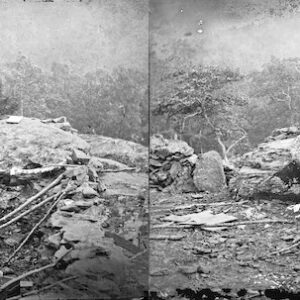| Credit: | by OSullivan (Timothy H.) |
|---|---|
| Date: | 1863.07 |
| Negative Size: | 8 in. x 10 in. |
| Locations & Lines: | Gettysburg PA; Gettysburg battlefield PA; Pennsylvania |
| Military Units: | CS Army; US Army |
| Sources: | Library of Congress; National Archives; Smithsonian Institution |
$6.99
File Details: AIAZm, 800 DPI, TIFF, Original Photograph, 41.9 Mb
Image ID: AIAZ
Gardners Photographic Sketch Book Of The War. Vol. 1, No. 38. Interior of Breastworks on Round Top, Gettysburg. July, 1863. The sketch represents a portion of the breastworks on the left of our line at Gettysburg, occupied by the Fifth and Sixth Corps, and against which, in the second days fight, the Confederates under Longstreet repeatedly and so impetuously dashed. This position is on a steep ridge known as Little Round Top, on which was stationed General Warren, Chief Engineer of the Army of the Potomac, with a signal officer, for the purpose of communicating to the commanding General the movements of the enemy. In front and to the left open fields stretched away, with here and there a small grove, which afforded shelter to sharpshooters, who annoyed our officers at the signal station excessively. Sickles, with the Third Corps, had opened the fight in the afternoon, considerably advanced in front of this position, with his left exposed, and the approach to the ridge entirely open to a flank movement. While the battle was raging fiercest in front, Longstreet, with fifteen thousand men, suddenly emerged from the woods into the open fields on our flank, and moved rapidly down upon Round Top, the occupation of which must inevitably have resulted in our defeat.
General Warren sent an aid to General Meade for a corps from the right, but the commanding General could not be found. A second staff officer was sent down to Sickles for some of his troops, but he could spare none, and another officer was hurried off to bring up any command that could be found, while the enemy still pressed nearer, threatening to overwhelm us. Sickles left was turned, his Corps pressed slowly back, and the Confederates commenced clambering up the rocky sides of the ridge, when the tramp of the Fifth Corps, on the double quick, was suddenly heard coming up through the woods to the rescue, and in a moment our colors flashed out from the foliage. Both armies reached the crest at the same time, the battle opened like a thunder-clap, and raged with terrific fierceness. After the first volley, our whole line charged with the bayonet, struggled with the enemy for a moment breast to breast, and then, with shouts and cheers, drove him in disorder down the slope to the shelter of the groves and stonewalls in the fields. Breastworks of stones and timber, shattered by the shells, were instantaneously thrown up, and after a brief interval the fight was renewed. Each change in the lines, by the fluctuations of battle, was marked by defences [sic] of stone, our troops never neglecting thus to protect themselves from the withering fire of the enemy. When night closed upon the field, these breastworks were stretched along like winnows marking the shifting tide of the struggle, between which the dead lay in countless numbers, and to-day the visitor traces by them, the steps of our advancing lines, which, though frequently repulsed, finally rested in triumph a the front.
Incidents of the War. Interior of Breastworks on Round Top, Gettysburg. July, 1863. [Gardner Co. cabinet card]


